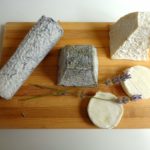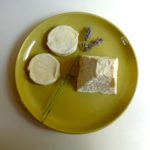 Cheese stands as a course of its own in France — and why not, in a country with more than 400 varieties to choose from? It is usually presented between the main course and fruit or dessert, with the number of cheeses ranging from one to many depending on the occasion and the number of people at the table. But which cheeses to choose and how to present them? A reader wrote in to ask this question. The subject is vast. Here goes.
Cheese stands as a course of its own in France — and why not, in a country with more than 400 varieties to choose from? It is usually presented between the main course and fruit or dessert, with the number of cheeses ranging from one to many depending on the occasion and the number of people at the table. But which cheeses to choose and how to present them? A reader wrote in to ask this question. The subject is vast. Here goes.
Assiette de fromages / Assorted cheeses
The first point is that, in a proper French meal, cheese is a must. You can’t skip it, as French friends tartly remarked one year at an American Thanksgiving dinner in Paris where the co-hostess and I had presumed that no one would have room for cheese, given the bounteous nature of the meal. We were taken to task and have not repeated the mistake. Is this to say that I serve cheese at every meal? Absolutely not! But when guests are present — and unless it is a meal where cheese would be inappropriate, like Vietnamese food — I prefer to err on the side of caution and bring out the cheese.
When I first came to France in 1969, I spent several weeks as a lodger with a family in Avignon while on a summer study program. This was my introduction to French cheese. It was served twice a day, at lunch and dinner, almost always accompanied by fresh fruit. Sometimes a single cheese was brought out, and sometimes an assortment, served on a simple plate, a board or a platter. The variety was astounding.
 With so many cheeses to choose from, where to begin? Cheeses are seasonal, varying according to the time of year when the milk is at its best and the amount of time needed for the cheese to mature. Cheeses at their best in spring include all types of chèvre (goat cheese, seen at right) and soft cheeses like Camembert, Brie and Epoisses. Cheeses that take a bit longer to mature, like Reblochon or Saint-Nectaire, come into their prime in summer. Autumn is the time to choose cheeses that have acquired character through longer maturation, like Roquefort, Ossau-Iraty (a hard Basque cheese made from ewe’s milk), Maroilles or Livarot. Winter is when cheeses needing the longest maturation come into their own: Comté and Beaufort, Cantal and Laguiole, and the unmatchable Mont d’Or, a meltingly delicious cheese eaten out of its round wooden box with a spoon.
With so many cheeses to choose from, where to begin? Cheeses are seasonal, varying according to the time of year when the milk is at its best and the amount of time needed for the cheese to mature. Cheeses at their best in spring include all types of chèvre (goat cheese, seen at right) and soft cheeses like Camembert, Brie and Epoisses. Cheeses that take a bit longer to mature, like Reblochon or Saint-Nectaire, come into their prime in summer. Autumn is the time to choose cheeses that have acquired character through longer maturation, like Roquefort, Ossau-Iraty (a hard Basque cheese made from ewe’s milk), Maroilles or Livarot. Winter is when cheeses needing the longest maturation come into their own: Comté and Beaufort, Cantal and Laguiole, and the unmatchable Mont d’Or, a meltingly delicious cheese eaten out of its round wooden box with a spoon.
Now the next question: How to compose your assortment? If you’ll be serving a considerable number of cheeses, as shown in the platter above, it’s best to present a wide variety — guests can each taste a couple of their favorites. The platter shows, going around the rim from top right, Chaource, Pont l’Evêque, Roquefort and Comté, and in the center Pouligny-Saint-Pierre. This assortment has three cheeses made of cow’s milk. The Roquefort is made of ewe’s milk and the Pouligny-Saint-Pierre is a chèvre.
 Harmony becomes more important when assembling a cheese plate for fewer people. As I’m partial to goat cheese, sometimes I’ll compose a plate with two or more types of chèvre, as seen at left. The plate includes Pouligny-Saint-Pierre (from south of the Loire) and two Rocamadours (from the Périgord).
Harmony becomes more important when assembling a cheese plate for fewer people. As I’m partial to goat cheese, sometimes I’ll compose a plate with two or more types of chèvre, as seen at left. The plate includes Pouligny-Saint-Pierre (from south of the Loire) and two Rocamadours (from the Périgord).  Sometimes I’ll go regional, selecting cheeses from, say, the rugged Auvergne region of south central France. The board at right includes Laguiole and Fourme d’Ambert, both made from cow’s milk. By the way, since blue cheeses, including Roquefort, are not to everyone’s taste, I usually include at least one non-blue cheese in the assortment. (An excellent site for taking a look at French cheeses is Chez Loulou.)
Sometimes I’ll go regional, selecting cheeses from, say, the rugged Auvergne region of south central France. The board at right includes Laguiole and Fourme d’Ambert, both made from cow’s milk. By the way, since blue cheeses, including Roquefort, are not to everyone’s taste, I usually include at least one non-blue cheese in the assortment. (An excellent site for taking a look at French cheeses is Chez Loulou.)
The cheese should be served at room temperature, which means taking it out of the fridge about an hour before you plan to bring it to the table. Much more could be said on the subject, such as how to cut the cheese (a conundrum even for the French), whether to bring it to the table still bearing its label (don’t), and what kind of cheese to choose if you’re not in France. I have touched on this here, and await any further questions.
Now then — getting back to France’s many types of cheese. The number has risen since President Charles de Gaulle famously said, ‘How can you hope to govern a country that has 258 varieties of cheese?’ According to the French dairy producers’ site, France today counts at least 1,200 varieties of cheese, of which 46 bear the label Appellation d’Origine Protégée, which attests that they come from a specific region and are made according to traditional methods. But they go on to say that the number could range up to 1,800. Which means that you could try one a day for nearly five years without repeating yourself…
Happy eating!
The Everyday French Chef will be on vacation for the next few weeks. Here’s wishing you all a very pleasant summer.




Thank you for this post!! Very informative!!